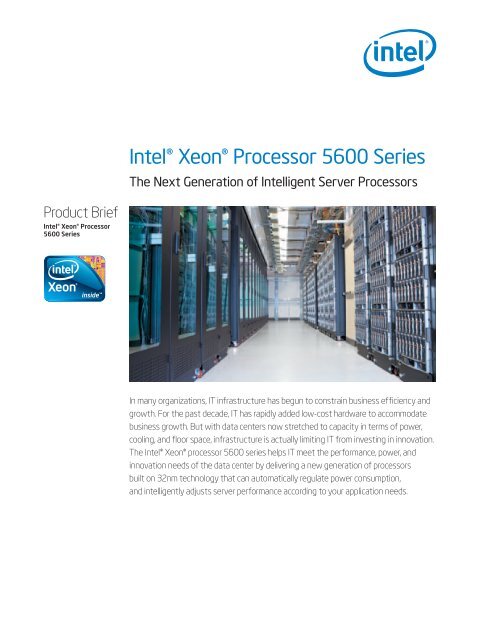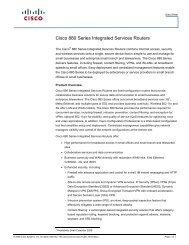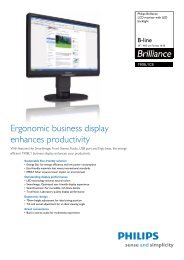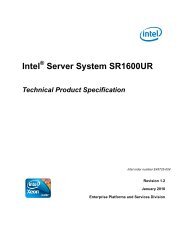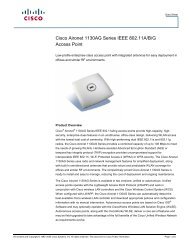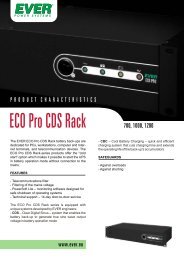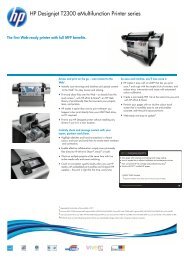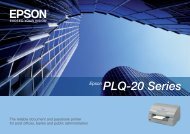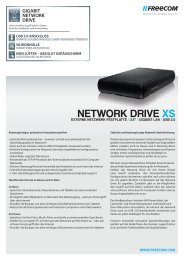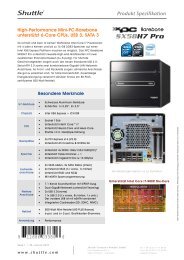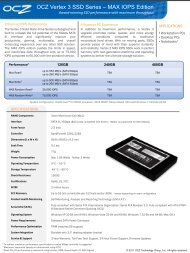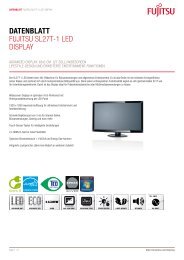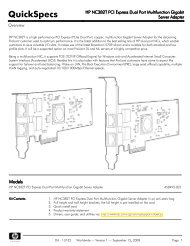Intel Xeon Processor 5600 Series - The Next Generation of ...
Intel Xeon Processor 5600 Series - The Next Generation of ...
Intel Xeon Processor 5600 Series - The Next Generation of ...
You also want an ePaper? Increase the reach of your titles
YUMPU automatically turns print PDFs into web optimized ePapers that Google loves.
Product Brief<br />
<strong>Intel</strong>® <strong>Xeon</strong>® <strong>Processor</strong><br />
<strong>5600</strong> <strong>Series</strong><br />
<strong>Intel</strong>® <strong>Xeon</strong>® <strong>Processor</strong> <strong>5600</strong> <strong>Series</strong><br />
<strong>The</strong> <strong>Next</strong> <strong>Generation</strong> <strong>of</strong> <strong>Intel</strong>ligent Server <strong>Processor</strong>s<br />
In many organizations, IT infrastructure has begun to constrain business efficiency and<br />
growth. For the past decade, IT has rapidly added low-cost hardware to accommodate<br />
business growth. But with data centers now stretched to capacity in terms <strong>of</strong> power,<br />
cooling, and floor space, infrastructure is actually limiting IT from investing in innovation.<br />
<strong>The</strong> <strong>Intel</strong>® <strong>Xeon</strong>® processor <strong>5600</strong> series helps IT meet the performance, power, and<br />
innovation needs <strong>of</strong> the data center by delivering a new generation <strong>of</strong> processors<br />
built on 32nm technology that can automatically regulate power consumption,<br />
and intelligently adjusts server performance according to your application needs.
Maximize Performance. Minimize Power. Automatically.<br />
As data centers reach the upper limits <strong>of</strong> their power and cooling<br />
capacity, efficiency has become the focus <strong>of</strong> extending the life <strong>of</strong><br />
existing data centers and designing new ones. As part <strong>of</strong> these efforts,<br />
IT needs to refresh existing infrastructure with standard enterprise<br />
servers that deliver more performance and scalability, more efficiently.<br />
<strong>The</strong> <strong>Intel</strong>® <strong>Xeon</strong>® processor <strong>5600</strong> series automatically regulates power<br />
consumption and intelligently adjusts server performance according<br />
to your application needs, maximizing both energy efficiency and<br />
performance. <strong>The</strong> secret to this compelling combination is <strong>Intel</strong>’s new<br />
32nm Nehalem microarchitecture. Featuring <strong>Intel</strong>® <strong>Intel</strong>ligent Power<br />
Technology ◊ that automatically shifts the CPU and memory into the<br />
lowest available power state, while delivering the performance you<br />
need, the <strong>Intel</strong> <strong>Xeon</strong> processor <strong>5600</strong> series with <strong>Intel</strong> Microarchitec-<br />
ture Nehalem delivers the same performance as previous-generation<br />
servers but uses up to 30 percent less power. 1 And you can achieve<br />
up to a 95 percent reduction in energy costs when consolidating<br />
your single-core infrastructure with a new infrastructure built on<br />
<strong>Intel</strong> <strong>Xeon</strong> processor <strong>5600</strong>. 2<br />
This groundbreaking intelligent server technology features:<br />
• <strong>Intel</strong>’s new 32nm Microarchitecture Nehalem built with<br />
second-generation high-k and metal gate transistor technology.<br />
• <strong>Intel</strong>ligent Performance that automatically optimizes<br />
performance to fit business and application requirements<br />
and delivers up to 40 percent more performance per watt<br />
than <strong>Intel</strong>® <strong>Xeon</strong>® processor 5500 series. 3<br />
• Automated Energy Efficiency that scales energy usage to<br />
the workload to achieve optimal performance/watt and with<br />
new 40 Watt options and lower power DDR3 memory, you<br />
can lower your energy costs even further.<br />
• Flexible virtualization that <strong>of</strong>fers best-in-class performance<br />
and manageability in virtualized environments to improve IT<br />
infrastructure and enable up to 15:1 consolidation over two<br />
socket, single-core servers. 2<br />
New standard enterprise servers and workstations built with this<br />
new generation <strong>of</strong> <strong>Intel</strong>® process technology <strong>of</strong>fer an unprecedented<br />
opportunity to dramatically advance the efficiency <strong>of</strong> IT infrastructure<br />
and provide unmatched business capabilities.<br />
2<br />
A Smart Investment<br />
Research shows that upgrading to multi-core servers with higher<br />
performing, more efficient processors can accelerate data center<br />
ROI, saving on power and cooling, space, labor, and s<strong>of</strong>tware licensing<br />
costs. By refreshing IT infrastructure with more energy-efficient<br />
systems, you gain capacity to grow and to increase IT performance,<br />
reduce energy costs by 95 percent, and realize ROI in 5 months. 2<br />
With up to 15x the performance compared to installed single-core<br />
servers 2 and unique virtualization capabilities, <strong>Intel</strong> <strong>Xeon</strong> processor<br />
<strong>5600</strong> series lets you deliver more business results from every clock<br />
cycle, every IT man-hour, every watt, and every inch <strong>of</strong> data center<br />
space. <strong>The</strong> lower TCO and groundbreaking performance <strong>of</strong> the <strong>Intel</strong><br />
<strong>Xeon</strong> processor <strong>5600</strong> series <strong>of</strong>fers the opportunity to transform<br />
the competitiveness <strong>of</strong> your business and the economics <strong>of</strong> your<br />
data center.<br />
Performance That Adapts<br />
to Your S<strong>of</strong>tware Environment<br />
Application performance is critical for day-to-day business operations,<br />
as well as creating new products and reaching new customers. But<br />
many data centers are now at capacity, and new data centers are<br />
expensive to build. By refreshing data center infrastructure with more<br />
efficient servers, you can deliver additional performance and scalability<br />
within the same energy and space footprint.<br />
<strong>The</strong> <strong>Intel</strong> <strong>Xeon</strong> processor <strong>5600</strong> series brings intelligent performance<br />
to the most widely deployed server architecture. <strong>The</strong> <strong>Intel</strong> <strong>Xeon</strong><br />
processor <strong>5600</strong> series is the world’s most adaptable server platform,<br />
adjusting performance and power usage in real time to meet the exact<br />
requirements <strong>of</strong> your computing workloads, while allowing manual<br />
adjustment for IT control.
<strong>The</strong> <strong>Intel</strong> <strong>Xeon</strong> processor <strong>5600</strong> series brings together a number <strong>of</strong><br />
innovative technologies to deliver intelligent performance:<br />
• <strong>Intel</strong>® Turbo Boost Technology, § together with <strong>Intel</strong> <strong>Intel</strong>ligent<br />
Power Technology, delivers performance on demand, letting processors<br />
operate above the rated frequency to speed specific workloads<br />
and reduce power consumption during low utilization periods.<br />
• <strong>Intel</strong>® Hyper-Threading Technology ф benefits from larger caches<br />
and massive memory bandwidth, delivering greater throughput<br />
and responsiveness for multi-threaded applications.<br />
• <strong>Intel</strong>® QuickPath Technology and an integrated memory controller<br />
speed traffic between processors and I/O controllers for bandwidth-<br />
intensive applications, delivering up to 4.4x the bandwidth for<br />
technical computing. 4<br />
<strong>The</strong> intelligent performance <strong>of</strong> the <strong>Intel</strong> <strong>Xeon</strong> processor <strong>5600</strong> series<br />
also gives IT fine-grained manual control to adapt to changing priorities<br />
or to meet service-level agreements (SLAs). For example, <strong>Intel</strong> <strong>Intel</strong>ligent<br />
Power Technology enables policy-based control that allows processors<br />
to operate at optimal frequency and power. <strong>The</strong> operating systems can<br />
make this determination automatically, or administrators can designate<br />
which applications require high-frequency processing and which should<br />
be executed at lower frequencies to conserve power.<br />
Performance<br />
Maximizes performance<br />
by adapting to the workload<br />
through <strong>Intel</strong>® Turbo Boost<br />
Technology and <strong>Intel</strong>®<br />
Hyper-Threading Technology<br />
Integrated<br />
Power Gates<br />
Energy Efficiency<br />
Automatically puts CPU into the<br />
lowest available power state while<br />
still meeting performance requirements<br />
World’s Most Adaptable Server Platform<br />
<strong>Intel</strong>® <strong>Xeon</strong>® <strong>Processor</strong> <strong>5600</strong> <strong>Series</strong><br />
<strong>Intel</strong>®<br />
Turbo Boost<br />
Technology<br />
Automated<br />
Lower Power<br />
States<br />
Automating Energy Efficiency<br />
After decades <strong>of</strong> IT build-out, server sprawl is escalating system<br />
management costs and outstripping available data center space,<br />
power and cooling capabilities. In a recent survey, 42 percent <strong>of</strong> data<br />
center owners said they would exceed power capacity within the next<br />
12-24 months, and 39 percent said they would exceed cooling capacity<br />
in the same timeframe. 5 Energy efficiency is becoming a critical issue in<br />
the data center.<br />
<strong>Intel</strong> <strong>Xeon</strong> processor <strong>5600</strong> series automatically regulates power<br />
consumption to combine industry-leading energy efficiency with<br />
intelligent performance that adapts to your workload. With capabilities<br />
such as new lower power SKUs and low-voltage memory options that<br />
can save up to 10 percent in memory power, 6 you can achieve up to<br />
40 percent better performance in a similar power envelope. 3 And the<br />
wide range <strong>of</strong> CPU, power, and memory options allows you to align<br />
your performance and energy requirements without having to make<br />
a trade-<strong>of</strong>f in either.<br />
In addition, <strong>Intel</strong> <strong>Intel</strong>ligent Power Technology makes power available<br />
for critical workloads while conserving power when there is less demand.<br />
<strong>Intel</strong> Turbo Boost Technology is also available, which allows processors<br />
to deliver higher speed execution on demand by using available power<br />
to run at a higher frequency, <strong>Intel</strong> <strong>Xeon</strong> processor <strong>5600</strong> series gives<br />
you the intelligent performance and flexibility you need to build the<br />
data center <strong>of</strong> the future today.<br />
Quad-Core with<br />
Hyper-Threading<br />
S<strong>of</strong>tware Adaptable<br />
<strong>The</strong> processor adapts<br />
to the way your application<br />
wants to run<br />
IT Adaptable<br />
You can enable automatic<br />
operation or selectively configure<br />
for manual control<br />
3
Maximizing Benefits from Virtualization<br />
<strong>Intel</strong> <strong>Xeon</strong> processor <strong>5600</strong> series can also help tame server sprawl<br />
by providing up to 15:1 consolidation capacity. 2 Built on <strong>Intel</strong> Microarchitecture<br />
Nehalem, the <strong>Intel</strong> <strong>Xeon</strong> processor <strong>5600</strong> series expands<br />
the benefits <strong>of</strong> virtualization beyond consolidation with innovations<br />
that can help boost performance, increase consolidation ratios, and<br />
enable servers <strong>of</strong> different generations to be combined in the same<br />
virtualized server pool, improving virtual machine failover, load balancing,<br />
and disaster recovery capabilities. With more performance in the same<br />
power envelope, you can use virtualization to deliver high-availability<br />
solutions with the agility to address disaster recovery and real-time<br />
workload balancing so your business can respond to the expected<br />
and the unexpected.<br />
<strong>Intel</strong> <strong>Xeon</strong> processor <strong>5600</strong> series with next-generation <strong>Intel</strong>®<br />
Virtualization Technology ∆ (<strong>Intel</strong>® VT) enhances virtualization<br />
performance by up to 3.5x and reduces roundtrip virtualization<br />
latency by up to 2x. 7<br />
Other virtualization features include:<br />
• <strong>Intel</strong>® Virtualization Technology (<strong>Intel</strong>® VT-x) continues to <strong>of</strong>fer<br />
investment protection and infrastructure flexibility with multi-<br />
generation VM migration across the full range <strong>of</strong> 32-bit and<br />
64-bit configurations, enabling bigger VM pools.<br />
• <strong>Intel</strong>® Virtualization Technology for Connectivity (<strong>Intel</strong>® VT-c)<br />
provides hardware-assisted I/O that accelerates network performance<br />
and simplifies VM migration.<br />
• <strong>Intel</strong>® Virtualization Technology for Directed I/O (<strong>Intel</strong>® VT-d) helps<br />
speed data movement and eliminates much <strong>of</strong> the performance<br />
overhead by giving designated VMs their own dedicated I/O devices,<br />
reducing the overhead <strong>of</strong> the VM migration in managing I/O traffic.<br />
<strong>Intel</strong>® Microarchitecture Nehalem helps<br />
lower energy costs with automated energyefficiency<br />
features that put processor power<br />
and memory into the lowest available states<br />
needed to support current workloads without<br />
compromising performance.<br />
4<br />
Secure, flexible virtualization<br />
As enterprises become borderless, security attacks rise – from DoS<br />
to phising to malware to data leakage. This keeps security challenges<br />
foremost in the minds <strong>of</strong> IT staff. And with the mixed environment in<br />
most data centers, servers are anything but secure. <strong>Intel</strong> <strong>Xeon</strong> processor<br />
<strong>5600</strong> series has two new security features that help you secure<br />
your data by speeding up data encryption and protecting against<br />
s<strong>of</strong>tware attacks at launch.<br />
Data encryption is not new, but new AES instructions from <strong>Intel</strong><br />
are. In the past, data encryption either required custom hardware,<br />
such as security appliances and HDDs, or took away from CPU<br />
performance to manage. But with <strong>Intel</strong>® AES (Advanced Encryption<br />
Standard) Technology, you get robust encryption without needing<br />
additional appliances or increased performance overhead. In fact,<br />
AES-NI improves CPU performance for encryption by as much as a<br />
52 percent for secure Internet transactions, 8 and allows for broader<br />
use <strong>of</strong> encryption throughout the data center.<br />
<strong>Intel</strong>® Trusted Execution Technology † (<strong>Intel</strong>® TXT) addresses a critical<br />
security need for all server deployments, especially virtualized and<br />
cloud-based use models by helping protect your server prior to OS<br />
launch or hypervisior launch. <strong>Intel</strong> TXT complements other malware<br />
protections such as anti-virus and intrusion detection to help ensure<br />
that only trusted s<strong>of</strong>tware is on the platform. VMs on trusted platforms<br />
are also protected, so you can easily migrate them onto other trusted<br />
platforms or create pools <strong>of</strong> platforms with trusted hypervisors.<br />
<strong>Intel</strong> <strong>Xeon</strong> processor <strong>5600</strong> series helps future pro<strong>of</strong> your data center<br />
with improved security features for evolving usage models.
Exploring <strong>Intel</strong>® Microarchitecture Nehalem<br />
<strong>The</strong> new generation <strong>of</strong> server processors from <strong>Intel</strong> provides a foundation for a fully adaptable IT environment.<br />
<strong>The</strong> architecture <strong>of</strong> these processors is designed with innovative features that adapt performance to s<strong>of</strong>tware<br />
and business needs, help energy consumption for optimum performance and efficiency, and enable virtualization<br />
strategies that help your IT infrastructure adapt more quickly to your business needs.<br />
<strong>Intel</strong>® Turbo Boost Technology<br />
<strong>Intel</strong> Turbo Boost technology delivers performance when and where<br />
it’s needed (see Figure 1). This technology allows processors to<br />
deliver higher speed execution on demand by using available<br />
power to run at a higher frequency.<br />
<strong>Intel</strong>® Hyper-Threading Technology<br />
Many server and workstation applications lend themselves to parallel,<br />
multi-threaded execution. <strong>Intel</strong> Hyper-Threading Technology enables<br />
simultaneous multi-threading within each processor core, up to two<br />
threads per core or eight threads per quad-core processor. Hyperthreading<br />
reduces computational latency, making optimal use <strong>of</strong><br />
every clock cycle. For example, while one thread is waiting for a<br />
result or event, another thread is executing in that core, to<br />
maximize the work from each clock cycle.<br />
Frequency<br />
CORE 0<br />
CORE 1<br />
CORE 2<br />
CORE 3<br />
All cores operate<br />
at rated frequency<br />
Higher Performance on Demand<br />
Normal 4C Turbo
<strong>Intel</strong>® <strong>Intel</strong>ligent Power Technology<br />
Within a single server, <strong>Intel</strong> <strong>Intel</strong>ligent Power Technology minimizes<br />
power consumption when server components are not fully utilized.<br />
• Integrated Power Gates (see Figure 3) allow individual idling<br />
cores to be reduced to near-zero power independent <strong>of</strong> other operating<br />
cores, reducing idle power consumption to 10 watts, versus<br />
16 or 50 watts in prior-generations <strong>of</strong> <strong>Intel</strong> processors. 9 This feature<br />
reduces server idle power consumption by up to 50 percent versus<br />
the previous generation <strong>of</strong> two-socket server processors. 10<br />
• Automated Low-Power States automatically put processor and<br />
memory into the lowest available power states that will meet the<br />
requirements <strong>of</strong> the current workload (see Figure 4). <strong>Processor</strong>s are<br />
enhanced with more and lower CPU power states, and the memory<br />
and I/O controllers have new power management features.<br />
<strong>Intel</strong>® Virtualization Technology<br />
<strong>Next</strong>-generation <strong>Intel</strong> Virtualization Technology enhances virtualization<br />
performance with new hardware-assist capabilities across all<br />
elements <strong>of</strong> your server:<br />
• <strong>Processor</strong>: Improvements to <strong>Intel</strong> Virtualization Technology (<strong>Intel</strong><br />
VT-x) provides hardware-assisted page-table management, allowing<br />
the guest OS more direct access to the hardware and reducing compute-intensive<br />
s<strong>of</strong>tware translation from the VMM. <strong>Intel</strong> VT-x also<br />
includes <strong>Intel</strong> VT FlexMigration and <strong>Intel</strong> VT Flex-Priority, which are<br />
capabilities for flexible workload migration and performance optimization<br />
across the full range <strong>of</strong> 32-bit and 64-bit operating environments.<br />
• Chipset: <strong>Intel</strong> Virtualization Technology for Directed I/O (<strong>Intel</strong> VT-d)<br />
helps speed data movement and eliminates much <strong>of</strong> the performance<br />
overhead by giving designated virtual machines their own dedicated<br />
I/O devices, thus reducing the overhead <strong>of</strong> the VMM in managing<br />
I/O traffic.<br />
6<br />
Automatic Operation or Manual Core Control<br />
Voltage (cores)<br />
Core 0 Core 1 Core 2 Core 3<br />
Memory, System, Cache, I/O<br />
Voltage (rest <strong>of</strong> processor)<br />
Figure 3. Integrated Power Gates enable idle cores to go to near-zero<br />
power independently.<br />
• Network Adapter: <strong>Intel</strong> Virtualization Technology for Connectivity<br />
(<strong>Intel</strong> VT-c) further enhances server I/O solutions by integrating extensive<br />
hardware assists into the I/O devices that are used to connect<br />
servers to the data center network and storage infrastructure. Two<br />
technologies comprise <strong>Intel</strong> VT-C: Virtual Machine Device Queues,<br />
which accelerates thoughput and reduces the load on the VMM and<br />
server processors; and PCI-SIG SR-IOV, which delivers near-native<br />
throughput and provides dedicated, direct connectivity between<br />
VMs and hardware resources. 11<br />
What is the 5000 Sequence?<br />
At <strong>Intel</strong>, our processor series numbers are intended to help clarify<br />
processor features, capabilities and intended usages. <strong>Intel</strong> <strong>of</strong>fers<br />
four processor number sequences for server applications:<br />
<strong>Intel</strong>® <strong>Xeon</strong>® processor 3000 sequence<br />
One-processor servers for small business, entry, or first server,<br />
based on the <strong>Intel</strong> <strong>Xeon</strong> processor.<br />
<strong>Intel</strong>® <strong>Xeon</strong>® processor 5000 sequence<br />
Two-processor general-purpose, standard high-volume servers,<br />
HPC systems, and workstations based on <strong>Intel</strong> <strong>Xeon</strong> processors.<br />
<strong>Intel</strong>® <strong>Xeon</strong>® processor 7000 sequence<br />
Greater performance and scalability with 4- to 32-processor<br />
enterprise servers. <strong>The</strong>se processors are designed for virtualization<br />
and data-demanding enterprise applications.<br />
<strong>Intel</strong>® Itanium® processor 9000 sequence<br />
Maximum scalability and RAS features for mission-critical workloads<br />
with 2- to 512-processor servers based on the <strong>Intel</strong> Itanium processor.<br />
Memory<br />
Controller<br />
<strong>Processor</strong><br />
ENHANCED Power<br />
Management<br />
Memory Memory<br />
I/O<br />
Controller<br />
<strong>Processor</strong><br />
Memory<br />
Controller<br />
NEW Power<br />
Management<br />
Figure 4. Automated Low-Power States adjusts system power<br />
consumption based on real-time load.
<strong>Intel</strong> <strong>Xeon</strong> <strong>Processor</strong> <strong>5600</strong> <strong>Series</strong><br />
<strong>The</strong> <strong>Intel</strong> <strong>Xeon</strong> processor <strong>5600</strong> series is available in a range <strong>of</strong> features to match different computing demands.<br />
All processors integrate <strong>Intel</strong> QuickPath Technology, <strong>Intel</strong> <strong>Intel</strong>ligent Power Technology and <strong>Intel</strong> Virtualization<br />
Technology. <strong>Intel</strong> VT FlexMigration, <strong>Intel</strong> VT FlexPriority, and <strong>Intel</strong>® 64 Architecture ‡ are standard on all SKUs.<br />
<strong>Processor</strong> Number ∆<br />
CPU<br />
Frequency<br />
<strong>Intel</strong>®<br />
Turbo Boost<br />
Technology<br />
<strong>Intel</strong>®<br />
HT<br />
Technology<br />
L3<br />
Cache<br />
Number<br />
<strong>of</strong> Cores Power<br />
<strong>Intel</strong>® QPI<br />
Link Speed<br />
DDR3<br />
Memory<br />
<strong>Intel</strong>® <strong>Xeon</strong>® <strong>Processor</strong> X5680 3.33 GHz • • 12 MB 6 130 W 6.4 GT/s a 1333, 1066, 800<br />
<strong>Intel</strong>® <strong>Xeon</strong>® <strong>Processor</strong> X5677 3.46 GHz • • 12 MB 4 130 W 6.4 GT/s 1333, 1066, 800<br />
<strong>Intel</strong>® <strong>Xeon</strong>® <strong>Processor</strong> X5670 2.93 GHz • • 12 MB 6 95 W 6.4 GT/s 1333, 1066, 800<br />
<strong>Intel</strong>® <strong>Xeon</strong>® <strong>Processor</strong> X5667 3.06 GHz • • 12 MB 4 95 W 6.4 GT/s 1333, 1066, 800<br />
<strong>Intel</strong>® <strong>Xeon</strong>® <strong>Processor</strong> X5660 2.80 GHz • • 12 MB 6 95 W 5.86 GT/s 1066, 800<br />
<strong>Intel</strong>® <strong>Xeon</strong>® <strong>Processor</strong> X5650 2.66 GHz • • 12 MB 6 95 W 5.86 GT/s 1066, 800<br />
<strong>Intel</strong>® <strong>Xeon</strong>® <strong>Processor</strong> E5640 2.66 GHz • • 12 MB 4 80 W 5.86 GT/s 1333, 1066, 800<br />
<strong>Intel</strong>® <strong>Xeon</strong>® <strong>Processor</strong> L5640 2.26 GHz • • 12 MB 6 60 W 5.86 GT/s 1066, 800<br />
<strong>Intel</strong>® <strong>Xeon</strong>® <strong>Processor</strong> E5630 2.53 GHz • • 12 MB 4 80 W 5.86 GT/s 1066, 800<br />
<strong>Intel</strong>® <strong>Xeon</strong>® <strong>Processor</strong> L5630 2.13 GHz • • 12 MB 4 40 W 5.86 GT/s 1066, 800<br />
<strong>Intel</strong>® <strong>Xeon</strong>® <strong>Processor</strong> E5620 2.40 GHz • • 12 MB 4 80 W 5.86 GT/s 1066, 800<br />
<strong>Intel</strong>® <strong>Xeon</strong>® <strong>Processor</strong> L5609 1.86 GHz 12 MB 4 40 W 5.86 GT/s 1066, 800<br />
a GT/s = giga-transfers/second<br />
Systems Designed for Your Needs<br />
Standard, Enterprise Servers: <strong>Intel</strong>® 5520 and 5500 Chipset<br />
Server and workstation platforms based on the <strong>Intel</strong>® 5520 and 5500<br />
Chipset, combined with the <strong>Intel</strong> <strong>Xeon</strong> processor <strong>5600</strong> series, drive<br />
breakthrough performance and state-<strong>of</strong>-the-art technology to performance<br />
and mainstream server platforms.<br />
<strong>The</strong> <strong>Intel</strong> 5520 Chipset supports the <strong>Intel</strong> <strong>Xeon</strong> processor <strong>5600</strong> series<br />
at 6.4 GT/s, 5.86 GT/s and 4.8 GT/s speeds via the <strong>Intel</strong> QuickPath<br />
Interconnect. Additionally, this chipset delivers support for 36 lanes <strong>of</strong><br />
PCI Express 2.0 I/O, <strong>Intel</strong> VT-c and <strong>Intel</strong> VT-d enhancements for virtualization<br />
OS, <strong>Intel</strong>® Dynamic Power Node Manager system management,<br />
and support for <strong>Intel</strong>® ICH10, ICH10R and <strong>Intel</strong>® 6700PXH 64-bit PCI Hub.<br />
<strong>The</strong> <strong>Intel</strong> 5500 Chipset supports the <strong>Intel</strong> <strong>Xeon</strong> processor 5500 series<br />
at 6.4 GT/s, 5.86 GT/s and 4.8 GT/s speeds via the <strong>Intel</strong> QuickPath<br />
Interconnect. Additionally, this chipset delivers support for 24 lanes <strong>of</strong><br />
PCI Express 2.0 I/O, <strong>Intel</strong> VT-c and <strong>Intel</strong> VT-d enhancements for virtualization<br />
OS, <strong>Intel</strong> Dynamic Power Node Manager system management,<br />
and support for <strong>Intel</strong> ICH10, ICH10R and <strong>Intel</strong> 6700PXH 64-bit PCI Hub.<br />
Workstations: <strong>Intel</strong> 5520 Chipset in Single<br />
or Dual I/O Hub (IOH) Configuration<br />
<strong>The</strong> <strong>Intel</strong> 5520 chipset improves data movement across <strong>Intel</strong> <strong>Xeon</strong><br />
processor 5500 series-based workstations and HPC systems by<br />
increasing interconnect bandwidth, optimizing system bandwidth,<br />
increasing memory capacity, and improving network traffic processing<br />
while reducing I/O latency.<br />
<strong>The</strong>se platform advancements help to match the improved performance<br />
<strong>of</strong> the <strong>Intel</strong> <strong>Xeon</strong> processor <strong>5600</strong> series and include:<br />
• Point-to-point connections via the <strong>Intel</strong> QuickPath Interconnect at<br />
4.8, 5.86 and 6.4 GT/s speeds<br />
• Dual IOH configuration for higher I/O connectivity, up to 72 lanes for<br />
PCI Express 2.0<br />
• Multiple x16 or x8 PCI Express 2.0 graphics card support<br />
• <strong>Intel</strong> VT-c and <strong>Intel</strong> VT-d virtualization technology enhancements<br />
• <strong>Intel</strong> Dynamic Power Node Manager system management support<br />
• <strong>Intel</strong> ICH10 and ICH10R<br />
• <strong>Intel</strong> 6700PXH 64-bit PCI Hub<br />
7
Learn More<br />
For more information on the <strong>Intel</strong> <strong>Xeon</strong> processor <strong>5600</strong> series,<br />
visit www.intel.com/xeon.<br />
For more information about <strong>Intel</strong> Microarchitecture Nehalem,<br />
visit www.intel.com/technology/architecture-silicon/next-gen.<br />
<strong>Intel</strong> processor numbers are not a measure <strong>of</strong> performance. <strong>Processor</strong> numbers differentiate features within each processor family, not across different processor families. See www.intel.com/products/processor_number for details.<br />
◊ <strong>Intel</strong> ® <strong>Intel</strong>ligent Power Technology requires a computer system with an enabled <strong>Intel</strong> ® processor, chipset, BIOS and for some features, an operating system enabled for it. Functionality or other benefits may vary depending on hardware<br />
implementation and may require a BIOS and/or operating system update. Please check with your system vendor for details.<br />
§ <strong>Intel</strong> ® Turbo Boost Technology requires a platform with a processor with <strong>Intel</strong> Turbo Boost Technology capability. <strong>Intel</strong> Turbo Boost Technology performance varies depending on hardware, s<strong>of</strong>tware and overall system configuration. Check with<br />
your platform manufacturer on whether your system delivers <strong>Intel</strong> Turbo Boost Technology. For more information, see http://www.intel.com/technology/turboboost.<br />
Ф Hyper-Threading Technology requires a computer system with a processor supporting Hyper-Threading Technology and an HT Technology enabled chipset, BIOS and operating system. Performance will vary depending on the specific<br />
hardware and s<strong>of</strong>tware you use. See www.intel.com/info/hyperthreading/ for more information including details on which processors support HT Technology.<br />
∆ <strong>Intel</strong> ® Virtualization Technology requires a computer system with an enabled <strong>Intel</strong> ® processor, BIOS, virtual machine monitor (VMM) and, for some uses, certain platform s<strong>of</strong>tware enabled for it. Functionality, performance or other benefits will<br />
vary depending on hardware and s<strong>of</strong>tware configurations and may require a BIOS update. S<strong>of</strong>tware applications may not be compatible with all operating systems. Please check with your application vendor.<br />
† No computer system can provide absolute security under all conditions. <strong>Intel</strong> ® Trusted Execution Technology is a security technology under development by <strong>Intel</strong> and requires for operation a computer system with <strong>Intel</strong> ® Virtualization Technology,<br />
an <strong>Intel</strong> Trusted Execution Technology-enabled processor, chipset, BIOS, Authenticated Code Modules, and an <strong>Intel</strong> or other compatible measured virtual machine monitor. In addition, <strong>Intel</strong> Trusted Execution Technology requires the system to<br />
contain a TPMv1.2 as defined by the Trusted Computing Group and specific s<strong>of</strong>tware for some uses. See http://www.intel.com/technology/security/ for more information.<br />
‡ 64-bit computing on <strong>Intel</strong> architecture requires a computer system with a processor, chipset, BIOS, operating system, device drivers and applications enabled for <strong>Intel</strong> ® 64 architecture. <strong>Processor</strong>s will not operate (including 32-bit operation)<br />
without an <strong>Intel</strong> 64 architecture-enabled BIOS. Performance will vary depending on your hardware and s<strong>of</strong>tware configurations. Consult with your system vendor for more information.<br />
1 Source: <strong>Intel</strong> internal measurements based on SPECint_rate_base2006 (Linux). Baseline Configuration and Score on Benchmark: Supermicro* pre-production system with two <strong>Intel</strong> ® <strong>Xeon</strong> ® processor X5570 (2.93 GHz, 8MB L3, 6.4 GT/s,<br />
Quad-core, 95W TDP), BIOS rev 01/06/2010 ,C3 Disabled, C6 Enabled, Turbo Enabled, HT Enabled, NUMA Enabled, Automatic Fan, 24 GB (6x4 GB DDR3-1333 DR registered ECC), 1x150 GB 10K RPM SATA HDD, 1x800w PSU, SLES 11<br />
kernel: 2.6.27.19-5-default x86_64. Source: <strong>Intel</strong> internal testing as <strong>of</strong> Feb 2010. SPECint_rate_base2006 score: 249. New Configuration and Score on Benchmark: Supermicro* pre-production system with two <strong>Intel</strong> ® <strong>Xeon</strong> ® processor L5640<br />
(2.26 GHz, 12MB L3, 5.86 GT/s, Hex-core, 60W TDP), BIOS rev 01/06/2010 ,C3 Disabled, C6 Enabled, Turbo Enabled, HT Enabled, NUMA Enabled, Automatic Fan, 24 GB (6x4 GB DDR3-1333 DR registered ECC), 1x150 GB 10K RPM SATA<br />
HDD, 1x800w PSU, SLES 11 kernel: 2.6.27.19-5-default x86_64. Source: <strong>Intel</strong> internal testing as <strong>of</strong> Feb 2010. SPECint_rate_base2006 score: 257.<br />
2 15:1 consolidation and 5 month ROI claim estimated based on comparison between 2S Single Core <strong>Intel</strong> ® <strong>Xeon</strong> ® 3.80 with 2M L2 Cache and 2S <strong>Intel</strong> ® <strong>Xeon</strong> ® processor X5680 series-based servers. Calculation includes analysis based on<br />
performance, power, cooling, electricity rates, operating system annual license costs and estimated server costs. This assumes 8kW racks, $0.10 per kWh, cooling costs are 2x the server power consumption costs, operating system license cost<br />
<strong>of</strong> $900/year per server, per server cost <strong>of</strong> $7200 based on estimated list prices and estimated server utilization rates. All dollar figures are approximate. Performance and power comparisons are based on measured server side java benchmark<br />
results (<strong>Intel</strong> Corporation Feb 2010). Platform power was measured during the steady state window <strong>of</strong> the benchmark run and at idle. Performance gain compared to baseline was 15x.<br />
Baseline platform: <strong>Intel</strong> server platform with two 64-bit <strong>Intel</strong> ® <strong>Xeon</strong> ® processor 3.80 Ghz with 2M L2 Cache, 800 FSB, 8x1GB DDR2-400 memory, 1 hard drive, 1 power supply, Micros<strong>of</strong>t Windows* Server 2003 Ent. SP1, Oracle JRockit* build<br />
P27.4.0-windows-x86_64 run with 2 JVM instances.<br />
New platform: <strong>Intel</strong> server platform with two <strong>Intel</strong> ® <strong>Xeon</strong> ® processor X5680 (12M Cache, 3.33 GHz, 6.40 GT/s <strong>Intel</strong> ® QPI), 24 GB memory (6x4 GB DDR3-1333), 1 SATA 10krpm 150GB hard drive, 1 800w power supply, Micros<strong>of</strong>t Windows*<br />
Server 2008 64 bit SP2, Oracle JRockit* build P28.0.0-29 run with 4 JVM instances.<br />
3 Up to 40% higher performance/watt compared to <strong>Intel</strong> ® <strong>Xeon</strong> ® processor 5500 <strong>Series</strong> claim supported by performance results on a server side java benchmark in conjunction with power consumption across a load line. <strong>Intel</strong> internal<br />
measurement (Jan 15, 2010).<br />
Baseline platform: <strong>Intel</strong> preproduction server platform with two Quad-Core <strong>Intel</strong> ® <strong>Xeon</strong> ® processor X5570, 2.93 GHz, 8 MB L3 cache, 6.4QPI, 8 GB memory (4x2 GB DDR3-1333), 1 PSU, Micros<strong>of</strong>t Windows* Server 2008 Enterprise SP2. <strong>Intel</strong><br />
internal measurement as <strong>of</strong> January 15, 2010.<br />
New platform: <strong>Intel</strong> preproduction server platform with two <strong>Intel</strong> ® <strong>Xeon</strong> ® processor X5670 (12M Cache, 2.93 GHz, 6.40 GT/s <strong>Intel</strong> ® QPI), 8 GB memory (4x2 GB DDR3-1333), 1 PSU, Micros<strong>of</strong>t Windows* Server 2008 Enterprise SP2. <strong>Intel</strong><br />
internal measurement as <strong>of</strong> January 15, 2010.<br />
4 STREAM_MP-Triad benchmark results comparing 2S <strong>Intel</strong> ® <strong>Xeon</strong> ® <strong>Processor</strong> E5472 (12M Cache, 3.00 GHz, 1600 MHz FSB), 16 GB memory (8x2 GB FB DDR2-800) based server platform to 2S <strong>Intel</strong> ® <strong>Xeon</strong> ® <strong>Processor</strong> X5680 (12M Cache,<br />
3.33 GHz, 6.40 GT/s <strong>Intel</strong> ® QPI) based server platform, 24 GB memory (12x4GB DDR3-1333). Source: <strong>Intel</strong> internal measurements SSG TR#942 and TR#1071 as <strong>of</strong> 12 February 2010.<br />
5 Infoworld, March 26, 2008.<br />
6 Based on voltage reduction from 1.50V to 1.35V, using Power (Watts) = I (current) x V (voltage)<br />
7 Performance results on VMmark benchmark. <strong>Intel</strong> ® <strong>Xeon</strong> ® processor X5470 data based on published results for HP Proliant ML370 G5 server platform with <strong>Intel</strong> ® <strong>Xeon</strong> ® processors X5470 3.33 GHz, 2x6 MB L2 cache, 1333 MHz FSB, 48 GB<br />
memory, VMware ESX* V3.5.0 Update 3 Published at 9.15@ 7 tiles vs. <strong>Intel</strong> reference platform using two <strong>Intel</strong> <strong>Xeon</strong> processors X5680 (12 M Cache, 3.33 GHz, 6.40 GT/s <strong>Intel</strong> ® QPI), 96 GB memory (12x 8 GB DDR3-800 Reg ECC DIMMs),<br />
VMware ESX* V4.0 Update 1. Performance measured at 32.25@ 26 tiles. Roundtrip latency for the different CPU generations based on internal <strong>Intel</strong> CPU architectural assessments for <strong>Intel</strong> ® <strong>Xeon</strong> ® processor <strong>5600</strong> series (Nehalem) relative to<br />
<strong>Intel</strong> ® <strong>Xeon</strong> ® processor 5400 series (Penryn).<br />
8 Source: Internal <strong>Intel</strong> measurements using a web banking workload running PHP and Windows Server 2008 R2, comparing number <strong>of</strong> banking sessions (users) for an <strong>Intel</strong> ® <strong>Xeon</strong> ® processor X5680 (3.33 GHz) vs. <strong>Intel</strong> <strong>Xeon</strong> ® processor X5570<br />
(2.93 GHz).<br />
9 Per <strong>Intel</strong> specifications, and depends on processor SKU.<br />
10 <strong>Intel</strong> internal measurements <strong>of</strong> 221W at idle with Supermicro* 2xE5450 (3.0 GHz 80W) processors, 8x2 GB 667MHz FBDIMMs, 1x700W PSU, 1x320 GB SATA hard drive vs. 108W at idle with Supermicro s<strong>of</strong>tware development platform with<br />
2xE5640 (2.66 GHz Westmere-EP 80W) processors, 6x2 GB DDR3-1066 RDIMMs, 1x800W PSU, 1x150 GB 10k SATA hard drive. Both systems were running Micros<strong>of</strong>t Windows* 2008 with USB suspend select enabled and maximum power<br />
savings mode for PCIe link state power management. Measurements as <strong>of</strong> Feb 2009 and Feb 2010.<br />
11 <strong>Intel</strong> internal measurement. (April 2008) Ixia* IxChariot* 6.4 benchmark. VMWare* ESX* v3.5U1. <strong>Intel</strong> ® <strong>Xeon</strong> ® processor E5355, 2.66 GHz, 8 MB L2 cache, 1333MHz system bus, 8GB memory (8x1 GB FB DIMM 667 MHz).<br />
Performance tests and ratings are measured using specific computer systems and/or components and reflect the approximate performance <strong>of</strong> <strong>Intel</strong> products as measured by those tests. Any difference in system hardware or s<strong>of</strong>tware design<br />
or configuration may affect actual performance. Buyers should consult other sources <strong>of</strong> information to evaluate the performance <strong>of</strong> systems or components they are considering purchasing. For more information on performance tests and on<br />
the performance <strong>of</strong> <strong>Intel</strong> products, visit <strong>Intel</strong> Performance Benchmark Limitations.<br />
INFORMATION IN THIS DOCUMENT IS PROVIDED IN CONNECTION WITH INTEL ® PRODUCTS. NO LICENSE, EXPRESS OR IMPLIED, BY ESTOPPEL OR OTHERWISE, TO ANY INTELLECTUAL PROPERTY RIGHTS IS<br />
GRANTED BY THIS DOCUMENT. EXCEPT AS PROVIDED IN INTEL’S TERMS AND CONDITIONS OF SALE FOR SUCH PRODUCTS, INTEL ASSUMES NO LIABILITY WHATSOEVER, AND INTEL DISCLAIMS ANY EXPRESS<br />
OR IMPLIED WARRANTY, RELATING TO SALE AND/OR USE OF INTEL PRODUCTS INCLUDING LIABILITY OR WARRANTIES RELATING TO FITNESS FOR A PARTICULAR PURPOSE,<br />
MERCHANTABILITY, OR INFRINGEMENTOF ANY PATENT, COPYRIGHT OR OTHER INTELLECTUAL PROPERTY RIGHT. UNLESS OTHERWISE AGREED IN WRITING BY INTEL, THE<br />
INTEL PRODUCTS ARE NOT DESIGNED NOR INTENDED FOR ANY APPLICATION IN WHICH THE FAILURE OF THE INTEL PRODUCT COULD CREATE A SITUATION WHERE<br />
PERSONAL INJURY OR DEATH MAY OCCUR.<br />
<strong>Intel</strong> may make changes to specifications and product descriptions at any time, without notice. Designers must not rely on the absence or characteristics <strong>of</strong> any features or instructions<br />
marked “reserved” or “undefined.” <strong>Intel</strong> reserves these for future definition and shall have no responsibility whatsoever for conflicts or incompatibilities arising from future changes to them.<br />
<strong>The</strong> information here is subject to change without notice. Do not finalize a design with this information. <strong>The</strong> products described in this document may contain design defects or errors known<br />
as errata which may cause the product to deviate from published specifications. Current characterized errata are available on request. Contact your local <strong>Intel</strong> sales <strong>of</strong>fice or your distributor<br />
to obtain the latest specifications and before placing your product order. Copies <strong>of</strong> documents which have an order number and are referenced in this document, or other <strong>Intel</strong> literature,<br />
may be obtained by calling 1-800-548-4725, or by visiting www.intel.com.<br />
Copyright © 2010 <strong>Intel</strong> Corporation. All rights reserved. <strong>Intel</strong>, the <strong>Intel</strong> logo, <strong>Xeon</strong>, Core, Itanium, and Core inside are trademarks <strong>of</strong> <strong>Intel</strong> Corporation in the U.S. and other countries.<br />
*Other names and brands may be claimed as the property <strong>of</strong> others.<br />
Printed in USA 0310/JH/OCG/XX/PDF Please Recycle 323501-001US


